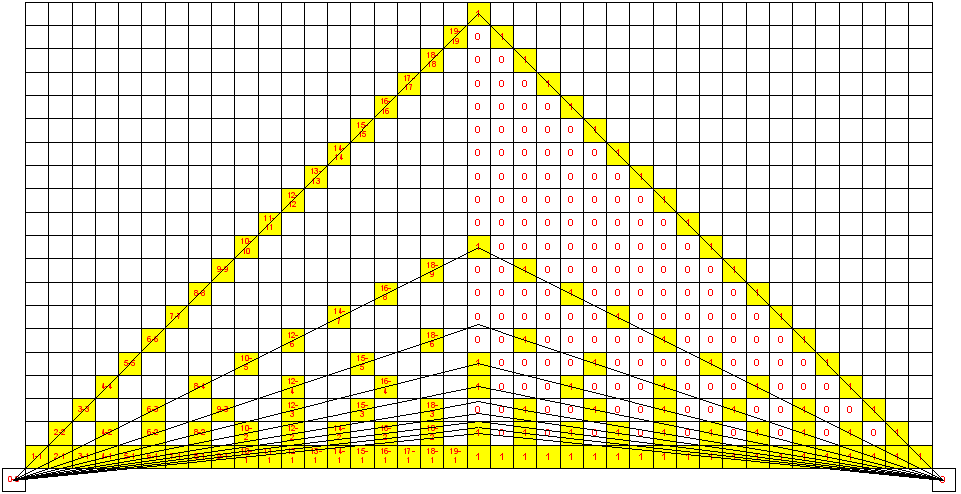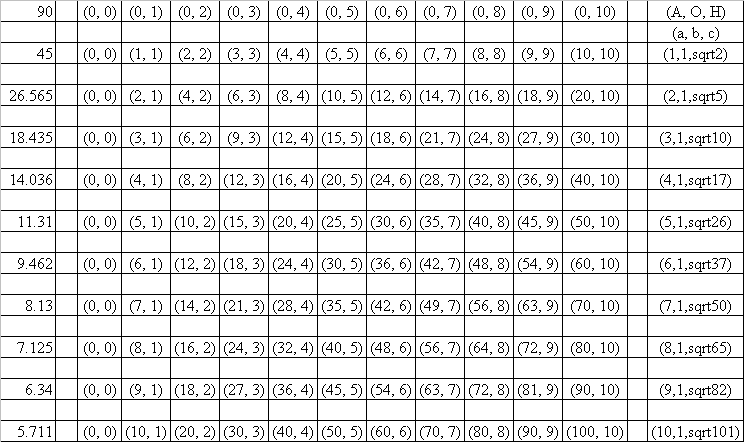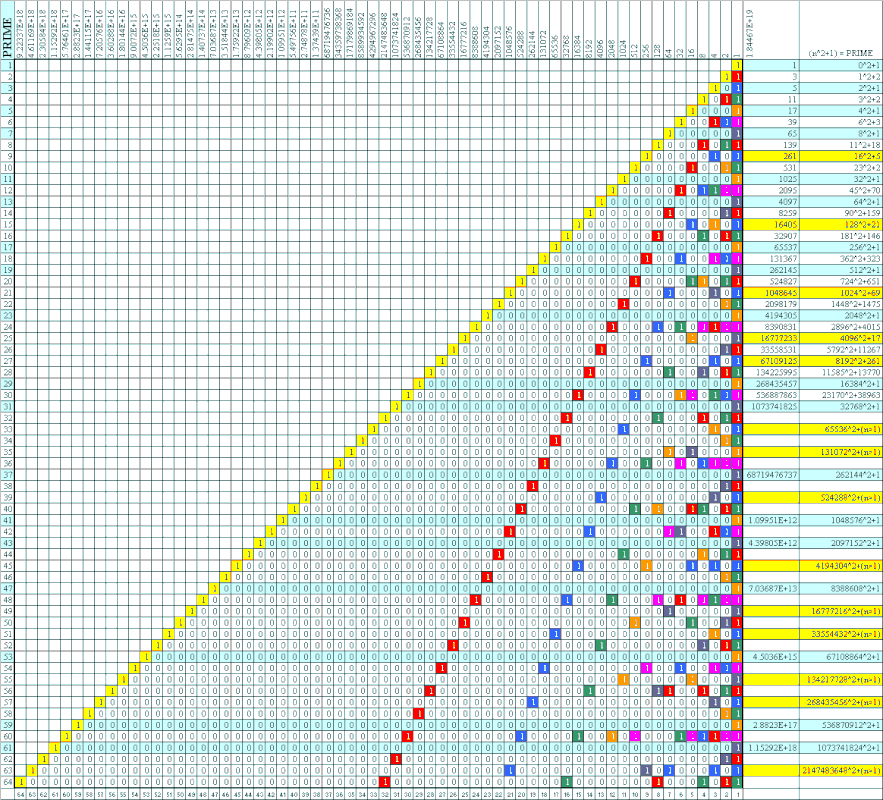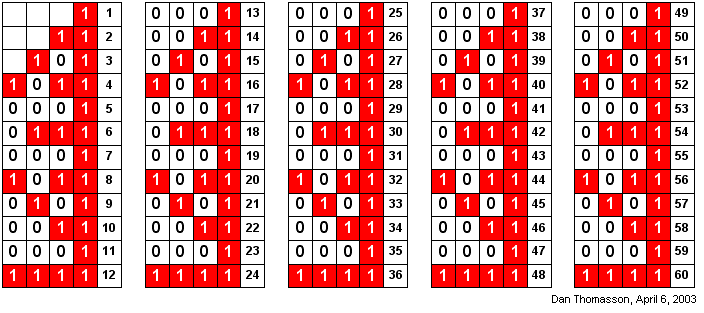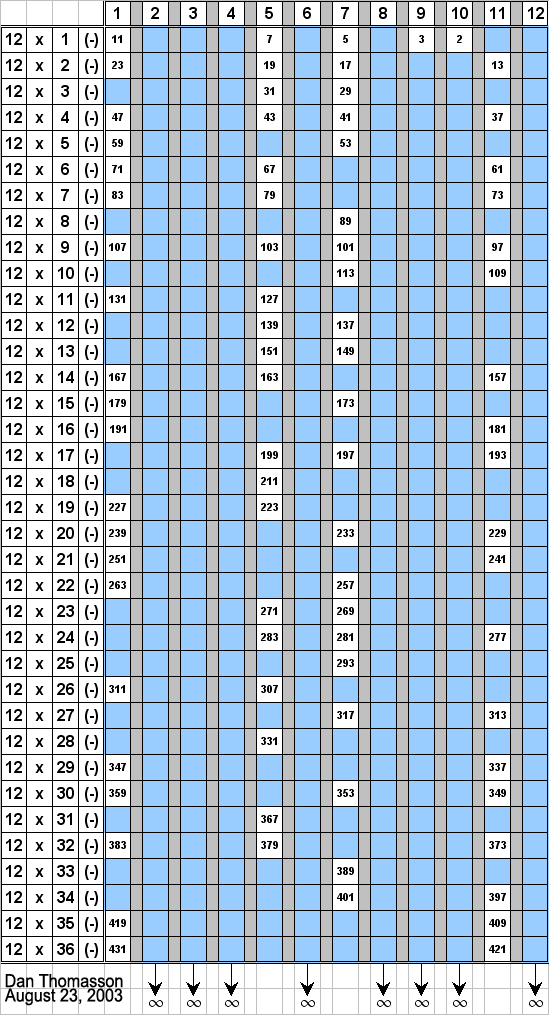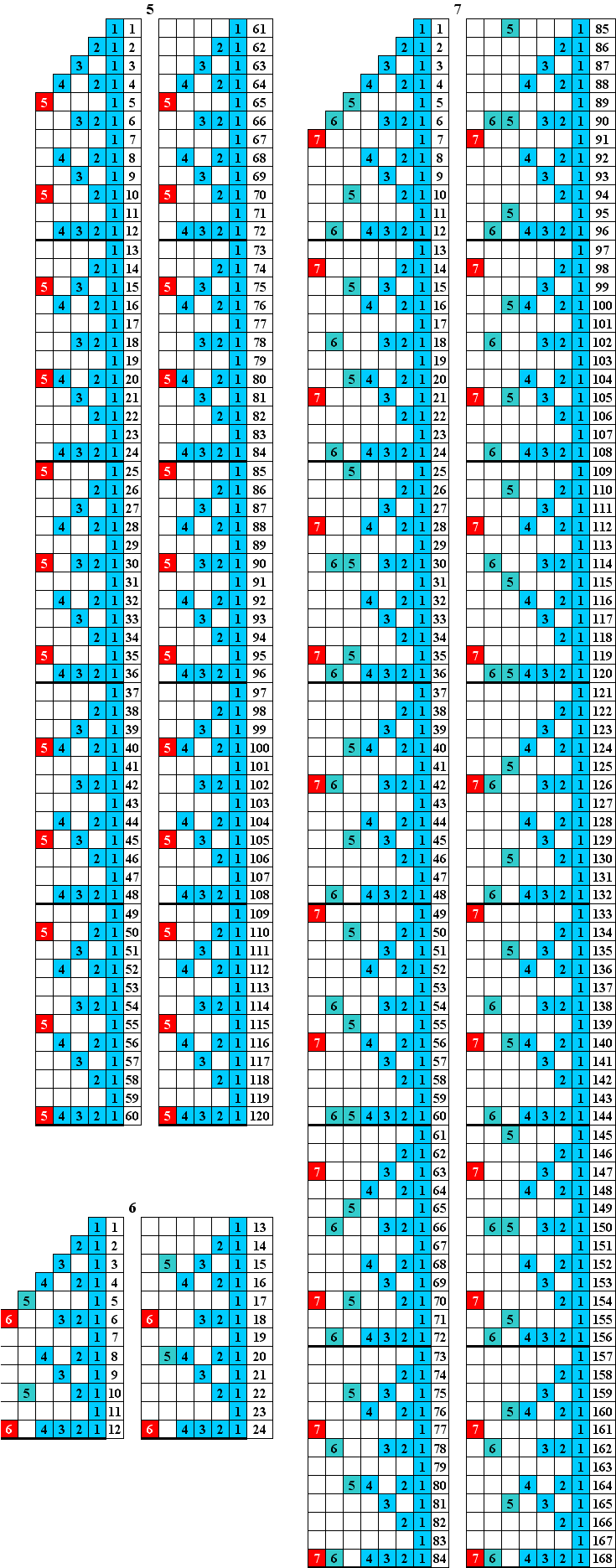From Knight Moves to Primes
From looking at the moves of the Knight on the chessboard, I wanted to find out what the slope angle in degrees was for the hypotenuse of the (2, 1) right triangle made by the Knight. I remembered from my old trigonometry days that I could use the Pythagorean Theorem to solve this problem. I also decided to find the angles for other types of similar triangles. I ultimately ended up with a neat summation formula. Select the formula below to see my math analysis.
After finding the angles in degrees from the formula, I plotted them on the following graph:
Later, I added x-y coordinates to the squares where the angled lines intersected whole integer pairs. I began to realize that the coordinates were the same numbers that represent the factors for each integer. I then made a mirror image of the chart and replaced all the x-y coordinates of each square with ones and zeros.
Before showing the binary and prime chart, here is a chart created by writing down the first 11 x-y coordinates of each angle starting with (0,0) from the previous chart. This new chart can be used as a multiplication chart. Increasing the length of the angled slopes in the previous chart will reveal additional integers and their factors that can be used to increase the size of the multiplication chart.
Since the factorial chart also looked like binary, I went ahead and created a new binary chart and overlaid the same angles (only inverted and rotated 90 degrees counter-clockwise) previously discovered. The chart ultimately reveals that all primes fit within a specific pattern made by the angles of right triangles found by my summation formula.
What can we learn from this new binary chart?
- The number 1 appears to be prime in the chart, but is it really a prime? The Webster's dictionary gives the definition of a prime number as: "having no polynomial factors other than itself and no monomial factors other than 1." It's a good thing I have the dictionary because now I have to look up polynomial and monomial.
According to Webster, "a polynomial is a mathematical expression of one or more algebraic terms each of which consists of a constant multiplied by one or more variables raised to a nonnegative integral power (a + bx + cx^2)." Also, a monomial is "a mathematical expression consisting of a single term." OK, maybe it is not such a good idea to use the dictionary definitions. In layman's terms, a prime number must have two factors and only two factors. Therefore, since 1 has only one factor, itself, it should not be considered a prime number, or is it according to my chart? - No even number can be prime, except 2. The number 2 matches all other prime numbers because it has a 1 at the beginning and at the end of the associated binary number in the chart with no additional 1's between it. In other words, it can only be evenly divided by itself or 1. Though my chart appears to show 2 as a non-prime based on all the facts, it is indeed a very special case - the only even prime.
- In the last column on the far right side of the chart, I state: n^2+1 = Prime. We all know that this is not a true equation. In all cases, except for the number 2, the equation is representative of the actual prime numbers highlighted in blue on the far left side of the chart. Besides number 2, every time a binary number in the chart is converted to decimal that equals the statement: n^2+1, a prime number exists on the left side of the chart.
- The chart can be used as a graphical representation of the sieve of Eratosthenes (276?-196? B.C.): "If N is a composite number then at least one of the prime factors of N is less than or equal to the square root of N." Mathematical Mysteries, by Calvin Clawson, page 153. To learn more about the sieve of Eratosthenes, read pages 77 and following in Mathematics: From the Birth of Numbers by Jan Gullberg.
- There is a specific repeatable pattern contained in the first 4 columns and first 12 rows on the right side of the chart.
The initial use of the above pattern allows number 2 and 3 to be prime. However, subsequent repetitions will never allow the patterns shown for 2, 3, 4, 6, 8, 9, 10, or 12 to be prime. Therefore, we know that at least 67% of all numbers cannot be prime. See the following chart for further clarification
Reducing the above chart to only 6 columns will show that all primes, except for numbers 2 and 3, fit in just two columns. Previous mathematicians have already provided such 6 column prime charts.
Even if Euler's Zeta Function or the Riemann Hypothesis defines all primes in relation to real numbers or complex numbers, there is still a gap in prime theory. Calvin Clawson's book: Mathematical Sorcery, states on page 213: "Euclid proved over two thousand years ago that an infinite number of primes exist, yet we know of no elementary formula that identifies each successive prime nor can we quickly determine if a large number is prime or not."
I hope that I am on the right path of helping to bridge the prime gap. Perhaps my illustrations will show that there is order to all prime numbers, and that a formula, such as the one I provided, can be created based on my analysis.
Additional observations:
Even if Euler's Zeta Function or the Riemann Hypothesis defines all primes in relation to real numbers or complex numbers, there is still a gap in prime theory. Calvin Clawson's book: Mathematical Sorcery, states on page 213: "Euclid proved over two thousand years ago that an infinite number of primes exist, yet we know of no elementary formula that identifies each successive prime nor can we quickly determine if a large number is prime or not."
I hope that I am on the right path of helping to bridge the prime gap. Perhaps my illustrations will show that there is order to all prime numbers, and that a formula, such as the one I provided, can be created based on my analysis.
Additional observations:
- The pattern for number 5 is repeated after the first 60 numbers. Only the first instance of 5 in the chart equates to prime.
- Number 6 represents the even numbers, and as you can see, it cannot be prime. It repeats its pattern after the first 12 numbers.
- The pattern for number 7 is repeated after the first 84 numbers.
- Not shown here is the pattern for number 9 that is repeated after the first 36 numbers.
- Also, not shown here is the pattern for number 11 that is repeated after the first 132 numbers.
General conclusion: An integer's (n) pattern that repeats after every n*12 number series is prime (5*12=60, 7*12=84, 11*12=132 …). 60, 84, and 132 respectively refer to the patterns and not actual prime numbers. All other integers are non-prime. In Mathematical Mysteries on page 156, Calvin Clawson states: "... the specific locations of the primes embedded within the natural numbers is so random that we cannot predict precisely where they will be." I have shown that not only can we predict where all primes reside in the natural number system, we know their exact locations which are by no means random according to my chart.


